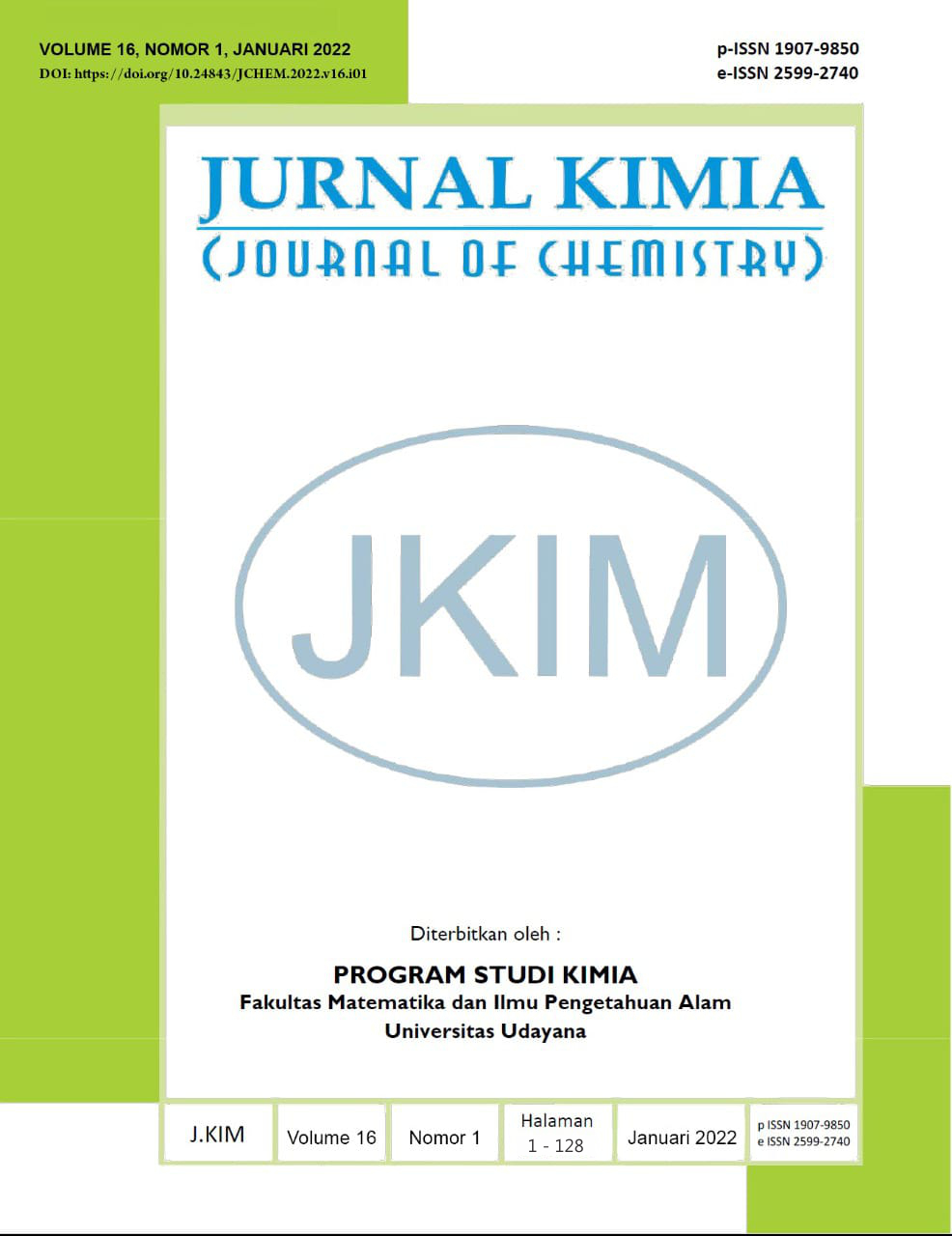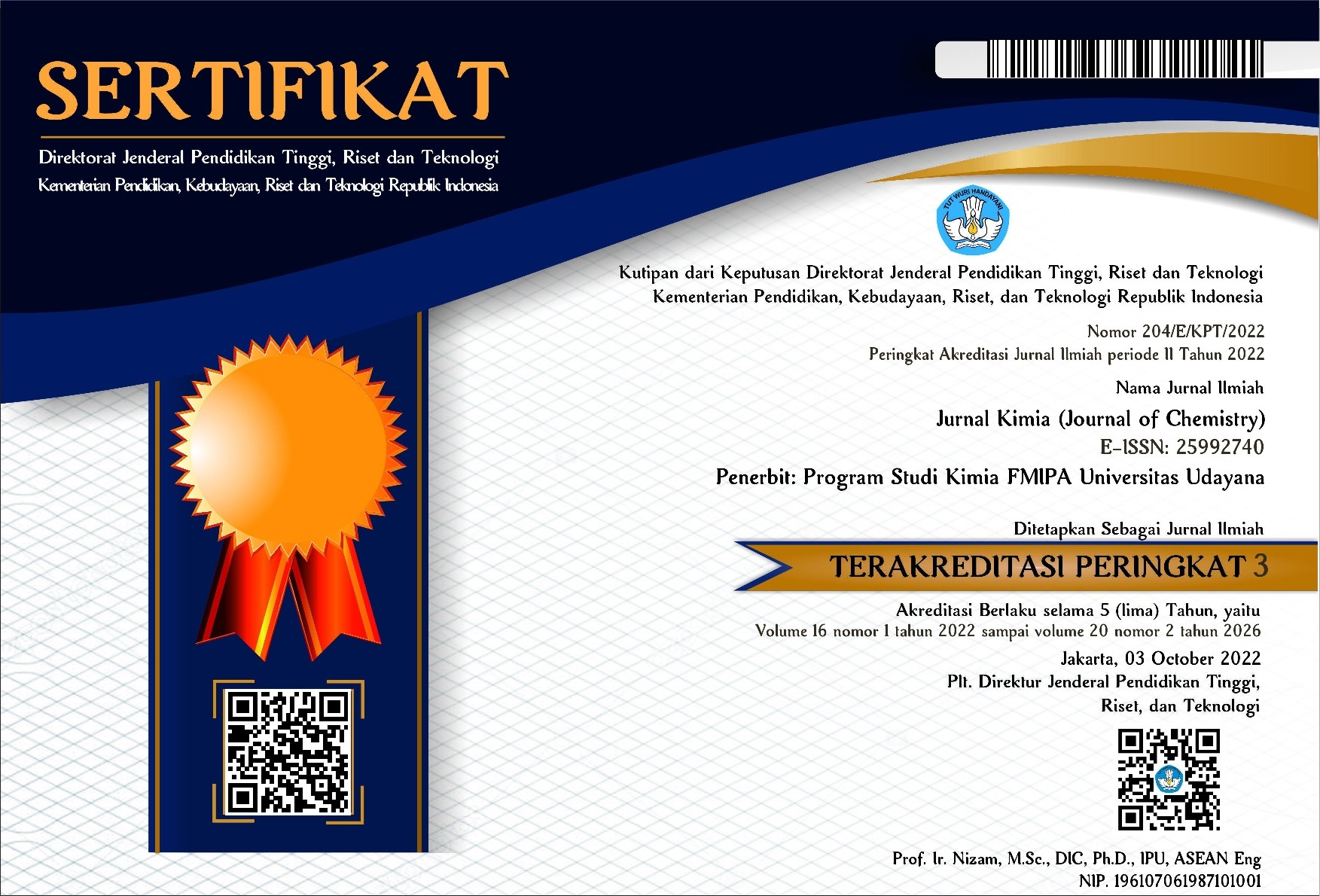AMIDATION CINNAMIC ACID BY DIETHYLAMINE WITH BORIC ACID AS CATALYST USING ULTRASONIC IRRADIATION
Abstract
Amides have important biological activities in medicine and agriculture. Amides can be synthesized in various ways, one of which is the direct reaction of carboxylic acid compounds and amines using boric acid as a catalyst. The purpose of this study was to synthesize N, N-diethyl cinnamamide compounds through direct amidation of cinnamic acid by diethylamine. The catalyst used was 5% mol of boric acid. The reaction process took place in a sonicator bath at 50oC within 40 minutes. The characterization of the compound was carried out by ATR-FTIR and 1H-NMR Spectrometry. The product of the synthesis was a 20,47% yellowish-white solid with a yield of a sapodilla fruit aroma. Identification using ATR-FTIR spectrometry showed several functional groups characteristic for Cinnamamide derivative, namely the C=O amide, C=C, C-N, aliphatic CH groups, monosubstituted benzene which were conjugated by a double bond. Characterization using 1H-NMR showed several chemical shifts for the compound N,N-diethyl cinnamamide. Based on these reason, it could be concluded that the compounds N, N-diethyl cinnamamide can be synthesized with good yields in a short time.
Keywords: amidation, boric acid, cinnamic acid, irradiation ultrasound, and N,N-diethyl cinnamamide.
Senyawa amida memiliki aktivitas biologi yang penting dalam bidang pengobatan dan juga pertanian. Amida dapat disintesis dengan berbagai cara, salah satunya adalah dengan reaksi langsung senyawa asam karboksilat dan amina menggunakan katalis asam borat. Tujuan dari penelitian ini adalah untuk mensintesis senyawa N,N-dietil sinamamida melalui amidasi langsung asam sinnamat oleh dietilamina. Katalis yang digunakan adalah asam borat 5% mol. Proses reaksi berlangsung dalam sonikator pada suhu 50oC dalam waktu 40 menit. Karakterisasi senyawa dilakukan dengan spektrometri ATR-FTIR dan 1H-NMR. Hasil sintesis berupa padatan putih kekuningan sebanyak 20,47% dengan aroma buah sawo. Identifikasi menggunakan spektrometri ATR menunjukkan beberapa gugus fungsi yang karakteristik untuk turunan sinamamida yaitu gugus C=O amida, C=C, C-N, CH alifatik, benzena monosubstitusi yang terkonjugasi oleh ikatan rangkap. Karakterisasi dengan 1H-NMR menunjukkan beberapa pergeseran kimia untuk senyawa N,N-dietil sinamamida. Berdasarkan hal-hal tersebut dapat disimpulkan bahwa hasil amidasi asam sinamat oleh dietilamina adalah N,N-dietil sinamamida dengan rendemen yang baik dalam waktu yang singkat.
Kata kunci: amidasi, asam borat, asam sinnamat, iradiasi ultrasonik dan N,N-dietil sinnamamida.
Downloads
References
Arce, G., Carrau, G., Bellomo, A., & Gonzalez, D. 2015. Greener Synthesis of an Amide by Direct Reaction of an Acid and Amine under Catalytic Conditions. World Journal of Chemical Education. 3(1): 27–29. https://doi.org/10.12691/wjce-3-1-4
Charville, H. 2012. Direct Amide Formation Between Carboxylic Acids and Amines: Mechanism and Development of Novel Catalytic Solutions. Durham University.
Charville, H., Jackson, D. A., Hodges, G., Whiting, A., & Wilson, M. R. 2011. The uncatalyzed direct amide formation reaction - Mechanism studies and the key role of carboxylic acid h-bonding. European Journal of Organic Chemistry, 30: 5981–5990. https://doi.org/10.1002/ejoc.201100714
Chatel, G. 2016. sonochemistry: New Opportunities for Green Chemistry. In World Scientific Publishing Europe Ltd. World Scientific Publishing Europe Ltd.
Coates, J. 2006. Encyclopedia of Analytical Chemistry - Interpretation of Infrared Spectra, A Practical Approach. In R. A. Meyers Ed. Encyclopedia of Analytical Chemistry. John Wiley & Sons Ltd. http://www3.uma.pt/jrodrigues/disciplinas/QINO-II/Teorica/IR.pdf
Dali, N., & Dali, A. 2017. Sintesis N - p- Metilbenzil- p -Kumaramida dari Asam p -Kumarat. Al-Kimia. 5(2): 154–160.
Dimmock, J. R., Gunda, S. G. R., Vashishtha, S. C., Zello, G. A., Nienaber, K. H., Stables, J. P., Allen, T. M., & Santos, C. L. 2004. Anticonvulsants containing the N-(3-aryl-2-propenoyl) amido pharmacophore. Journal of Enzyme Inhibition and Medicinal Chemistry. 19(4): 303–312. https://doi.org/10.1080/14756360409162442
Ernawati, T., Mun’Im, A., Hanafi, M., & Yanuar, A. 2020. Synthesis of cinnamamide derivatives and their α-glucosidase inhibitory activities. Sains Malaysiana. 49(2): 315–322. https://doi.org/10.17576/jsm-2020-4902-09
Ernawati, T., & Nurhalimah, N. 2017. Sintesis N -Oktilsinamamid dan Aktivitasnya terhadap Sitotoksik Sel Kanker Leukemia P388 Synthesis N -Octylcinnamamide and Cytotoxicity Activity against P388 Leukemia Cancer Cells. Kimia Valensi. 3(November): 127–133.
Fattah, A., Firdaus, & Soekamto, N. H. 2020. Synthesis of a Cinnamic Acid Derivative and Bioactivity as an Anticancer Based on Result Quantitative Structure Activity Relationship (QSAR) Analysis. Indo. Chim. Acta. 13(1): 23–29.
Huy, P., & Zoller, B. 2019. Boron Lewis Acid Catalysis: How to Synthesize Amides Atom-Efficiently. Nachrichten Aus Der Chemie (Journal of the German Chemical Society GDCh). 67(5): 51–54. https://doi.org/10.1002/nadc.20194087418
Ken, M. L., Tagg, T., & Khairul, W. M. 2019. Synthesis and characterisation of N-analineferrocenylamide via carbodiimide coupling. Malaysian Journal of Analytical Sciences. 23(2): 186–196. https://doi.org/10.17576/mjas-2019-2302-02
Lee, J.-S., Zeller, M., Warkad, S. D., & Nimse, S. B. 2019. Synthesis, Characterization, and Crystal Structure of N-(3-nitrophenyl)cinnamamide. Crystals 2019. 9(599): 1–10.
Leggio, A., Bagalà, J., Belsito, E. L., Comandè, A., Greco, M., & Liguori, A. 2017. Formation of amides: One-pot condensation of carboxylic acids and amines mediated by TiCl4. Chemistry Central Journal. 11(1): 1–12. https://doi.org/10.1186/s13065-017-0318-9
Mirza-Aghayan, M., Tavana, M. M., & Rabah, B. 2016. Sulfonated reduced graphene oxide as a highly efficient catalyst for direct amidation of carboxylic acids with amines using ultrasonic irradiation. Ultrasonics Sonochemistry. 29: 371–379. https://doi.org/10.1016/j.ultsonch.2015.10.009
Nimse, S. B., Pal, D., Mazumder, A., & Mazumder, R. 2015. Synthesis of Cinnamanilide Derivatives and Their Antioxidant and Antimicrobial Activity. Journal of Chemistry. 1–6. https://doi.org/10.1155/2015/208910
Pathan, R. U., & Agarkar, S. V. 2014. SiO 2 Supported Synthesis of N , N Disubstituted Cinnamamides. Research Journal of Chemical Sciences. 4(5): 56–58.
Permatasari, D. A. I., & Ritmaleni. 2019. N- ( 2-chlorobenzyl ) formamide , a Novel Synthesized Antituberculosis Evaluation by Microplate Alamar Blue Assay. 170–173.
Pulle, J. S. 2020. Synthesis Of Amides By Activation Of Carboxylic Acids Using Phosphonitrilic Chloride. Indo American Journal of Pharmaceutical Research. 10(1): 599–604. https://doi.org/10.1002/chin.200605269
Seelolla, G. 2014. Synthesis, Antimicrobial and Antioxidant Activities of Novel series of Cinnamamide Derivatives having Morpholine Moiety. Medicinal Chemistry. 4(12): 778–783. https://doi.org/10.4172/2161-0444.1000229
Shahrisa, A., Esmati, S., & Nazari, M. G. 2012. Boric acid as a mild and efficient catalyst for one-pot synthesis of 1-amidoalkyl-2-naphthols under solvent-free conditions. Journal of Chemical Sciences. 124(4): 927–931. https://doi.org/10.1007/s12039-012-0285-6
Tang, P. 2012. Discussion Addendum for: Boric Acid Catalyzed Amide Formation From Carboxylic Acids And Amines: N-Benzyl-4-Phenylbutyramide. Organic Syntheses. 89: 432–437. https://doi.org/10.15227/orgsyn.089.0432
Yualanda, V. G., Sary, I. P., & Pangaribowo, D. A. 2018. Sintesis dan Uji Aktivitas Antibakteri Senyawa N-Fenil-3,4-Diklorobenzamida (Synthesis and Antibacterial Activity Assay of N-Phenyl-3,4-Dichlorobenzamide). Pustaka Kesehatan. 6(1): 5. https://doi.org/10.19184/pk.v6i1.6610

This work is licensed under a Creative Commons Attribution 4.0 International License






